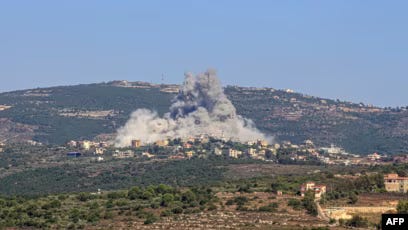Why Iran is Gaslighting Hezbollah to Attack Israel: Analyzing the Shia-Sunni Dynamic and the Looming Israel-Lebanon War
Iran's masterplan to weaken Sunni influence in Lebanon exposed
Introduction
The recent escalation between Hezbollah and Israel has once again brought the fragile peace in the region to the brink of collapse. While many view these skirmishes as part of the long-standing Israeli-Palestinian conflict, there are deeper, more intricate geopolitical motives at play, particularly involving Iran and its proxy, Hezbollah. This article delves into why Iran is instigating Hezbollah to provoke Israel, the violations of international resolutions, and the broader Shia-Sunni conflict that underpins these tensions.
The Role of Hezbollah
Hezbollah, a Shia militant group based in Lebanon, has been a thorn in Israel's side for decades. Supported and funded by Iran, Hezbollah has repeatedly launched attacks on northern Israel, aiming to destabilize the region and assert its influence. Recently, Hezbollah's aggression escalated dramatically with a tragic incident where many Israeli children were killed while playing soccer. This blatant act of violence has intensified the already volatile situation.
In the aftermath of the 2006 Lebanon War, the UN Security Council adopted Resolution 1701 to cease hostilities between Hezbollah and Israel. The resolution called for the disarmament of all armed groups in Lebanon, including Hezbollah, and an end to the smuggling of weapons. Despite this, Hezbollah has continuously violated the resolution by maintaining its armed presence and frequently attacking northern Israel. These violations undermine efforts for long-term peace and stability in the region.
Iran's Strategy and Motives
Iran's involvement in Lebanon through Hezbollah is a strategic maneuver to extend its influence and counterbalance Sunni powers in the Middle East. By inciting Hezbollah to attack Israel, Iran aims to provoke a broader conflict that could weaken its adversaries. Iran's support for Hezbollah is not just about confronting Israel but also about consolidating Shia power in a region predominantly led by Sunni-majority nations. These motives are not a new phenomenon; they are deeply rooted in the historical Shia-Sunni divide and Iran's long-standing ambition to diminish Sunni influence in the region.
The Shia-Sunni Conflict: Historical Context and Modern Implications
The Shia-Sunni conflict is one of the most enduring and complex sectarian divides in the Islamic world, originating shortly after the death of the Prophet Muhammad in 632 AD. The initial dispute was over the rightful successor to lead the Muslim community. Shias believed that Ali, the Prophet’s cousin and son-in-law, was the rightful successor, while Sunnis supported Abu Bakr, a close companion of the Prophet. This split led to the Battle of Karbala in October of 680 AD, a pivotal event that solidified the division between the two sects.
Over the centuries, this divide has influenced political, social, and religious dynamics across the Muslim world:
Safavid Empire (1501-1736): The establishment of the Safavid dynasty in Persia (modern-day Iran) marked the beginning of Shia Islam as the state religion, creating a Shia power center that often clashed with the Sunni Ottoman Empire.
Modern Geopolitics: In the 20th and 21st centuries, the geopolitical rivalry between Shia-majority Iran and Sunni-majority Saudi Arabia has been a significant factor in regional conflicts. This rivalry manifests in various proxy wars and political struggles, such as the Iran-Iraq War (1980-1988), where Saddam Hussein’s Sunni-dominated regime in Iraq fought against Shia-majority Iran.
Proxy Conflicts: In recent years, the Shia-Sunni divide has been a key factor in the Syrian Civil War, the conflict in Yemen, and the ongoing instability in Iraq. Iran’s support for Shia militias and political groups in these countries aims to expand its influence and counter Sunni dominance.
Iran's Current Strategy
Iran's strategic objective is to weaken Sunni influence and promote Shia dominance in the region. By pushing Hezbollah into conflict with Israel, Iran seeks to destabilize Lebanon, a country with a significant Sunni population, and undermine Sunni political power. This approach aligns with Iran's broader goal of creating a "Shia Crescent" stretching from Iran through Iraq and Syria to Lebanon, thereby solidifying its regional influence.
Just like Hamas, which uses civilians as human shields in its conflicts with Israel, Hezbollah might employ similar tactics, targeting Sunni civilians and hiding among them to provoke Israeli retaliation. This approach not only increases civilian casualties but also aims to turn public opinion against Israel and further inflame sectarian tensions.
Hezbollah's Impact on Lebanon
Hezbollah's actions have significant repercussions for Lebanon's political and social stability. The group's military activities and confrontations with Israel often result in severe civilian casualties and infrastructure damage. If a full-scale war between Israel and Lebanon were to break out, the consequences would be devastating. Lebanon's already fragile economy and political system could collapse, leading to further chaos and hardship for its citizens. Iran's role in this potential downfall cannot be overstated, as it manipulates Hezbollah to serve its broader regional ambitions.
Conclusion
The recent provocations by Hezbollah against Israel are not isolated incidents but part of a broader, more complex geopolitical strategy orchestrated by Iran. Understanding the Shia-Sunni dynamics and Iran's motives is crucial to comprehending the ongoing conflict. As tensions escalate, it is the civilians on both sides who bear the brunt of this geopolitical chess game.






The Muslim wars never end.
If they win their war and everybody else is dead they will fight amongst each other till they destroy the world.
This is why I believe Islam is Satan inspired.
Great analysis by the way.